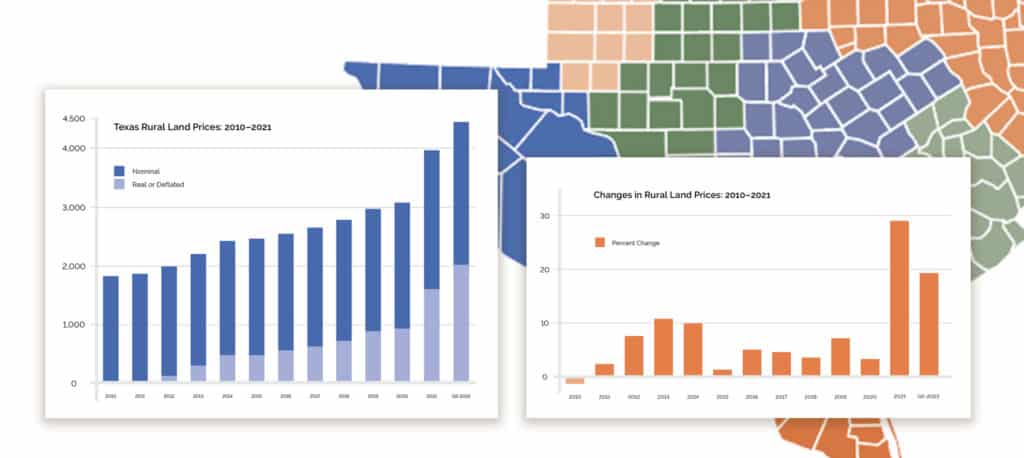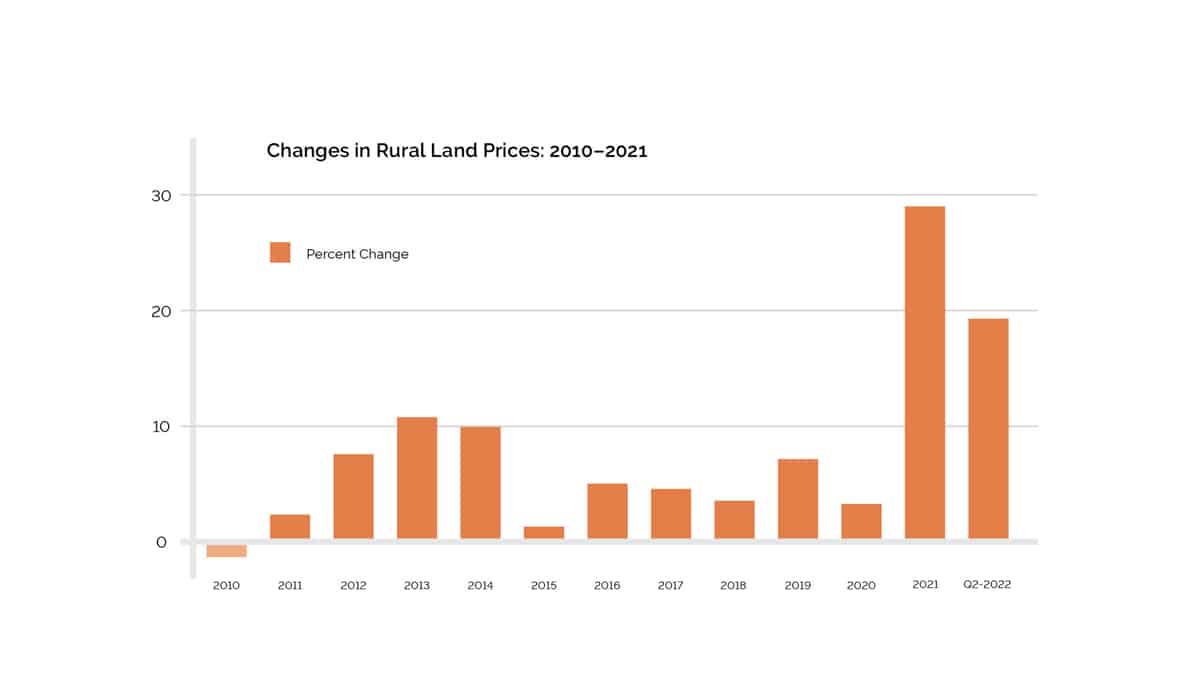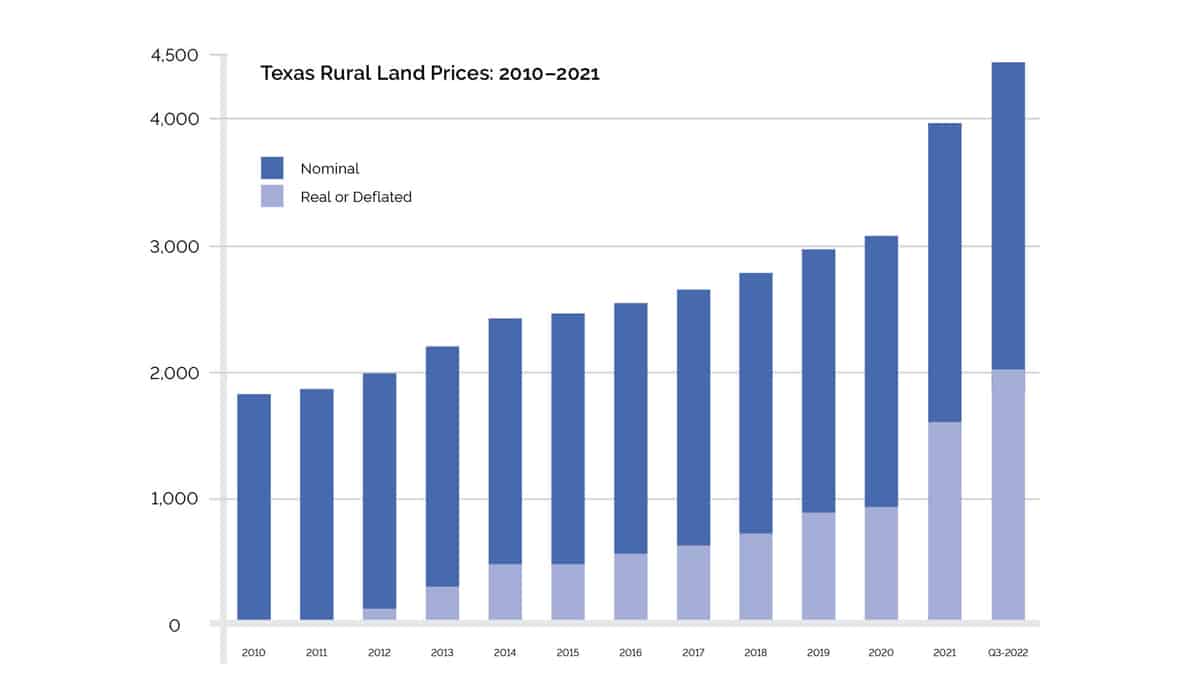

This article is featured in the Winter 2022 issue of Texas LAND magazine. Click here to find out more.
Activity in Texas markets continues to ebb from the frenetic pace seen in 2021. Preliminary indications of the number of third quarter sales from the Texas Real Estate Research Center has fallen 35 percent from third quarter 2021 quarterly levels. Final numbers will likely trim that percentage, but the second quarter total lagged 24 percent below the level experienced in 2021. Indeed, year over year comparisons of volume indicate declines for three straight quarters. In addition, observers report that inventories of properties for sale have risen substantially in selected major markets. Total dollar volume at $3.4 billion grew a modest six percent solely driven by a strong price increase.


Price trends continued to set records as the statewide price rose to $4,420 per acre, a 19 percent increase over 2021 levels. Rising prices accompanied by volume declines have traditionally signaled a fundamental change in the market environment. Often, these developments signal weakening demand that results in fewer sales of lesser quality lands. Overall price indicators continue to climb because sales of lower quality land begin to dwindle while the proportion of top-quality land composes a larger proportion of the sales. The change in market composition disguises weakening demand by posting higher average prices. At first, observers rejected the thought that markets have weakened arguing that volume declines resulted from a lack of inventory for sale. However, reports of increasing numbers of properties for sale cast doubt on that hypothesis and suggest that the months ahead may see price performance return to pre-pandemic levels. Currently, activity still exceeds pre-pandemic volumes with sharply higher prices.

- Panhandle & South Plains. Prices rose 26 percent during the third quarter to $1,547 per acre and total acres moved up 24 percent to 198,881 acres. The number of sales dropped 24 percent to 444 sales. Total dollar volume was up 56 percent to $308 million.
- Far West Texas. Activity remained sparse with only 25 reported sales in this region. However, those sales pushed total acreage up 83 percent to 45,764 acres. Prices slipped down 33 percent to $1,076 per acre. Few sales at historically very high prices makes it difficult to establish a reading of market conditions here.
- West Texas. Sales activity declined 33 percent to 835 sales, but prices rose 13 percent to $2,143 per acre. Total acreage remained steady, up only one percent to 246,954 acres. At $529 million, total dollar volume increased 15 percent.
- Northeast Texas. Volume declined 35 percent to 1,927 sales with prices increasing 22 percent to $7,755 per acre. However, total acreage declined 42 percent to 65,498 acres. Despite rising prices, total dollar volume declined 29 percent to $508 million. Final reports will likely soften the sizable decline in volume statistics.
- Gulf Coast–Brazos Bottom. Volume also dropped in this region, down 30 percent to 911 sales. In addition, total acres dropped 16 percent to 43,543 acres. Prices increased a substantial 19 percent to $9,388 per acre. Total dollar volume remained flat at $409 million.
- South Texas. Sales activity flagged in the region south of San Antonio, falling 29 percent to 630 sales. Acreage receded 38 percent to 59,847 acres. Prices grew 22 percent to $5,522 per acre. This activity drove total dollar volume down 25 percent to $330 million.
- Austin-Waco-Hill Country. Prices in central Texas topped 2021 prices by 26 percent, rising to $6,651 per acre. However, total dollar volume declined 41 percent to $735 million. Total acres sold dropped 36 percent to 110,483 acres.
The Future
The explosion in the volume of transactions in rural property appears to have returned to pre-COVID levels as Federal Reserve interest rate hikes and rampant inflation hit buyers’ disposable incomes. Investors, buyers motivated by the desire to own rural retreats, and farmers and ranchers continue to do buy land but at a noticeably reduced pace.
Observers report evidence that the number of listings is increasing while the number of transactions has slowed. As the rising Fed funds rate inflicts distress on the economy, activity will likely slow further and price increases may moderate.